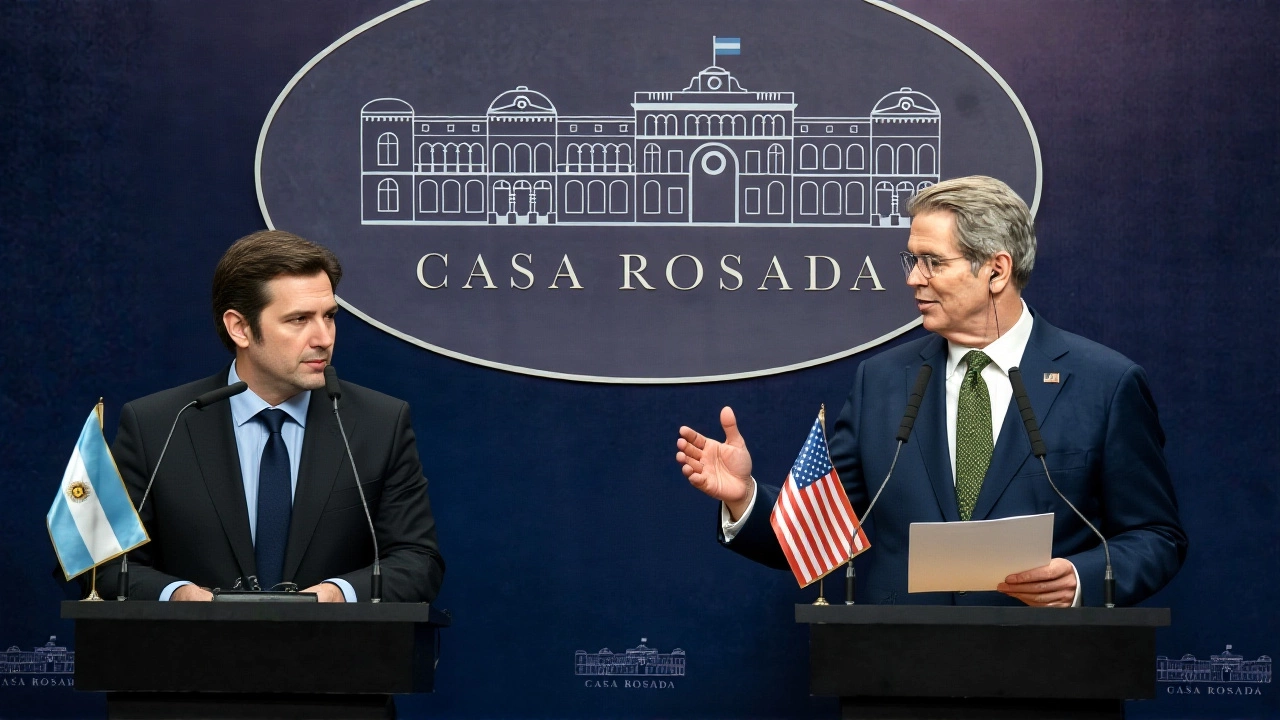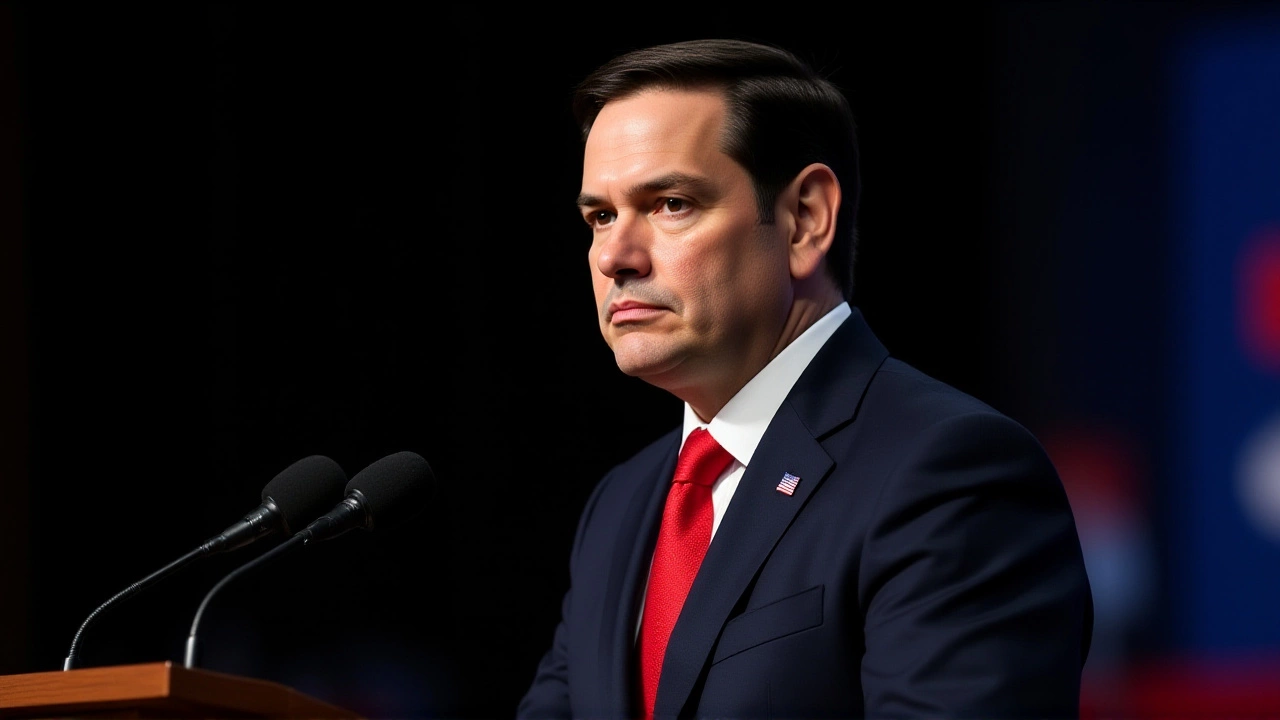 Nov, 20 2025
Nov, 20 2025
When Marco Rubio landed in Panama on February 1, 2025, it wasn’t just another foreign trip—it was a signal. As the newly confirmed Secretary of State under President Donald Trump, Rubio’s first international journey wasn’t to NATO allies or Asian partners. It was to Central America and the Caribbean. That choice spoke louder than any policy memo. In the first ten months of Trump’s second term, top officials have made over a dozen high-profile visits across Latin America, turning a region once treated as a diplomatic afterthought into a frontline of U.S. strategy. The message? This isn’t about aid or diplomacy anymore. It’s about control, commerce, and countering China—on their doorstep.
From Panama to Venezuela: A Cabinet on the Move
Secretary of State Marco Rubio didn’t just visit. He covered ground. Between February and March 2025, he hit Panama, El Salvador, Costa Rica, Guatemala, the Dominican Republic, Jamaica, Guyana, and Suriname. Each stop followed a script: pressuring governments to accept deported migrants, securing support for U.S. trade deals, and quietly warning against Chinese infrastructure deals—especially around the Panama Canal. The Americas Society/Council of the Americas (AS/COA), which tracks these movements, called it “unprecedented in speed and scope.” Then came Secretary of Homeland Security Kristi Noem. In March, she rolled into Colombia and El Salvador, then Mexico, before returning in June to Guatemala and Honduras. Her mission? Border enforcement. She didn’t just meet officials—she toured detention centers, announced new funding for surveillance tech, and publicly threatened to cut aid to any country that didn’t “take back its own people.” In Honduras, she told reporters, “We’re not asking. We’re demanding cooperation.” Secretary of Defense Pete Hegseth made his own splash in April, visiting the Panama Canal and meeting with military leaders. His trip was less about diplomacy and more about theater. He arrived with a small contingent of Marines, gave a speech in full uniform at a U.S. base, and referenced “the need to protect American interests from hostile actors”—a clear nod to China’s growing presence in the region. Critics called it provocative. Supporters called it necessary. Even Special Envoy Rick Grenell got in on the action, flying to Caracas in January 2025 for a secret meeting with opposition figures. The White House never confirmed the visit—but leaks suggest he offered financial support to anti-Maduro groups. The administration’s message was clear: Venezuela was fair game.Trade Wars and Tariffs: The Economic Hammer
While officials were flying south, the administration was slamming the region with economic blows. In March 2025, Trump signed an executive order raising tariffs on steel, aluminum, and agricultural imports from Argentina, Brazil, Canada, and Mexico to 50%. That’s double what they were under Biden. The Fundacion Carolina report estimated that Mexican exports to the U.S. could drop by 30% in 2025, costing over $12 billion in lost revenue. But here’s the twist: at the same time, the White House announced “Joint Statements on Frameworks” with El Salvador, Argentina, Ecuador, and Guatemala. These deals eliminate tariffs on U.S. manufactured goods and open markets for American tech and energy firms. It’s a classic carrot-and-stick: punish the big players, reward the loyal ones. The White House claimed these moves “strengthened economic security.” But economists at the Institute for Global Affairs warned it’s a zero-sum game. “You can’t demand cooperation on migration while crushing your neighbors’ economies,” said analyst Lina Mendoza. “This isn’t partnership. It’s coercion.”
Security, Not Solidarity: The Military Shift
Perhaps the most alarming shift is in security policy. The Institute for Global Affairs survey in November 2025 found that 44% of Americans support U.S. military strikes against drug cartels in Latin America—even without host government approval. Among Republicans, that number jumps to 78%. Trump has taken no formal congressional authorization for such operations, but Defense Department officials have reportedly begun joint exercises with Colombian and Honduran forces under the guise of “counter-narcotics training.” Meanwhile, Vice President JD Vance has emerged as the administration’s enforcer, often sitting in on meetings with Latin leaders, making it clear that dissent won’t be tolerated. One leaked memo from a meeting in San Salvador read: “The president doesn’t need your permission. He needs your compliance.”What’s Next? The Domino Effect
The administration’s strategy is starting to ripple. Brazil is quietly seeking new trade partners in Africa and Asia. Chile has suspended talks on a new U.S. investment pact. Even longtime allies like Colombia are pushing back on the migrant deportation demands, citing human rights concerns. But the biggest question remains: how long can this strategy hold? The U.S. still buys more than 40% of Latin America’s exports. But resentment is growing. In Mexico City, protests against the tariffs drew 20,000 people in October. In Quito, students burned effigies of Trump and Hegseth. And while the White House celebrates “historic wins,” local economies are feeling the squeeze. The AS/COA says it will continue tracking visits through 2026. Next up? A rumored trip by Treasury Secretary Scott Bessent to Peru and Chile—possibly to pressure them into joining the U.S.-led mineral supply chain initiative. If it happens, it’ll be another chapter in what’s becoming less a foreign policy and more a campaign of influence.
Background: A Departure from the Past
Under Biden, the U.S. pledged $2.2 billion in foreign aid to Latin America in FY 2025—mostly for health, climate resilience, and democratic institutions. Trump’s 2025 budget slashed that to $450 million, redirecting funds to border security and military cooperation. The shift isn’t just about dollars. It’s about values. Where Biden spoke of “partnership,” Trump speaks of “deal-making.” Where Biden emphasized human rights, Trump emphasizes results. It’s working—for some. El Salvador’s president, Nayib Bukele, has openly praised Trump’s tough stance on migration. But in Haiti, where U.S. travel restrictions have tightened since January, hospitals are running out of insulin. In Venezuela, the sanctions have deepened the humanitarian crisis.Frequently Asked Questions
How are these policies affecting ordinary people in Latin America?
In countries like Mexico and Argentina, small businesses are struggling as tariffs raise the cost of U.S. parts and machinery. In Honduras, increased deportations have overwhelmed local shelters, with over 15,000 returned migrants in 2025—up 40% from 2024. In Venezuela, sanctions have worsened medicine shortages, with WHO reporting a 60% drop in insulin availability. The human cost is rising even as officials tout economic deals.
Why is China such a big concern in Latin America right now?
China has invested over $140 billion in Latin America since 2005, including ports, railways, and 5G networks. In Panama, Chinese firms manage 40% of the canal’s logistics. In Ecuador, they helped build a new hydroelectric dam. The Trump administration sees this as a strategic threat—especially as China gains diplomatic influence. U.S. officials now frame every infrastructure project as a “debt trap,” even when local governments welcome the investment.
Are these trade deals actually benefiting U.S. workers?
So far, the benefits are concentrated in specific industries. U.S. tech firms are gaining market access in El Salvador and Guatemala, and energy companies are securing long-term contracts in Ecuador. But for American manufacturing workers, the story is mixed. While some factories are reopening due to cheaper inputs, others are losing orders as Latin American countries shift trade to Asia. The net effect on U.S. jobs remains unclear.
What’s the legal basis for U.S. military actions without congressional approval?
The administration is relying on the 2001 AUMF (Authorization for Use of Military Force) and the president’s constitutional authority as commander-in-chief. Legal experts argue this stretches the law thin—especially since no formal war has been declared. Congress has not voted on any new authorization, and several lawmakers have filed lawsuits challenging the legality of cross-border drone operations targeting cartels.
How does this compare to past U.S. interventions in Latin America?
It echoes the Cold War era, when the U.S. backed coups and sanctions to counter communism. But today’s tools are different: tariffs, deportation threats, and economic coercion instead of CIA operatives. The goal is similar—dominance without direct occupation. What’s new is the scale and speed. No previous administration has coordinated so many cabinet-level visits in so short a time, nor weaponized trade so openly.
